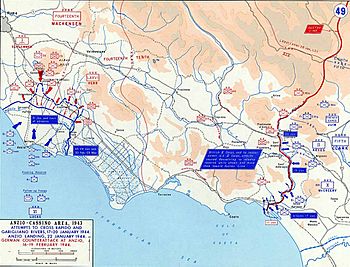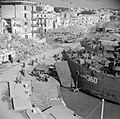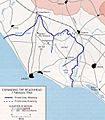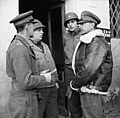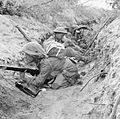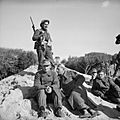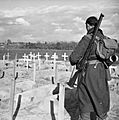Battle of Anzio facts for kids
Quick facts for kids Operation Shingle |
|||||||
|---|---|---|---|---|---|---|---|
| Part of the Winter Line and the battle for Rome of the Italian Campaign of World War II | |||||||
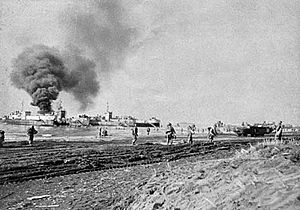 U.S. Army soldiers landing at Anzio in late January 1944. |
|||||||
|
|||||||
| Belligerents | |||||||
| Commanders and leaders | |||||||
| Strength | |||||||
| Initially: 36,000 soldiers and 2,300 vehicles Breakout: 150,000 soldiers and 1,500 guns |
Initially: 20,000 German soldiers + five Italian battalions (4,600 soldiers) Breakout: 135,000 German soldiers + two Italian battalions |
||||||
| Casualties and losses | |||||||
| 43,000 casualties (7,000 killed, 36,000 wounded or missing) |
40,000 casualties (5,000 killed, 30,500 wounded or missing, 4,500 prisoner) |
||||||
The Battle of Anzio, also known as Operation Shingle, was a major sea landing by Allied forces during World War II. It took place on January 22, 1944, in Italy, near the towns of Anzio and Nettuno. The goal was to attack German forces from behind their main defense lines. This battle was part of the larger Italian Campaign.
American Major General John P. Lucas led the attack. His plan was to go around the strong German defenses, called the Winter Line. Then, the Allies hoped to quickly move towards Rome and capture it. Landing troops on the marshy coast needed to be done very fast.
The landing caught the Germans by surprise. Allied troops even got close to Rome. However, the Allies spent time getting their forces ready on the beach. This gave the German commander time to bring in his guns and surround the beach area. The Germans also flooded the marshland with salt water to make it harder for the Allies to move.
After about a month of very tough fighting, the Allies finally broke out from the beaches in May. They moved north-west and captured Rome on June 4. Even with this success, the German Tenth Army was able to retreat north of Rome. They then prepared new defenses along the Gothic Line.
Contents
Why the Anzio Landing Happened
At the end of 1943, Allied forces were fighting in Italy. They were stopped at a strong German defense line called the Gustav Line. This line stretched across Italy. The mountains and difficult land in central Italy made it very hard for the Allies to break through.
British Prime Minister Winston Churchill came up with the idea for Operation Shingle in December 1943. He wanted to land two army divisions at Anzio. This would help the Allies get around the Gustav Line and capture Rome.
General Harold Alexander had a bigger plan. He thought about using five divisions. But the Allied 5th Army did not have enough soldiers or ships to carry them. The beaches at Anzio and Nettuno were on marshy land. When General Lucian Truscott's 3rd Division was chosen for the attack, he worried it would be very dangerous. General Lucas was chosen to lead the U.S. VI Corps for the landing.
How the Attack Was Planned
The main idea was that if the Allies landed at Anzio, German forces would have to leave the Gustav Line. This would weaken the Gustav Line, allowing other Allied forces to break through. If the Germans stayed on the Gustav Line, the Allies at Anzio could try to capture Rome.
The Allies planned to attack from the south. They wanted to quickly take control of a beach near Anzio. From there, they would push forward and get ready to move towards Rome.
Getting Enough Ships
One big problem for the plan was not having enough landing ships. At first, there were only enough tank landing ships (LSTs) to land one army division. Churchill later made sure that enough ships were available to land two divisions.
Who Was Involved in the Attack
The Allied forces for this attack were very large. They included 5 cruisers, 24 destroyers, and 238 landing craft. There were also more than 62 other ships. About 40,000 soldiers and over 5,000 vehicles took part.
The attack was divided into three main groups:
- The British force, called "Peter Beach," landed about 6 miles north of Anzio.
- The northwestern U.S. Force, called "Yellow Beach," attacked the port of Anzio itself.
- The southwestern U.S. Force, called "X-Ray Beach," landed about 6 miles east of Anzio.
Attack from the South
Before the Anzio landing, the Allied Fifth Army attacked the Gustav Line. This attack began on January 16, 1944, at Monte Cassino. However, this attack did not succeed in breaking through. The Germans were able to bring in new troops from Rome to defend their line.
The Battle Begins
First Landings at Anzio
The landings at Anzio began on January 22, 1944. The Germans were surprised and did not strongly resist the initial landings. There were only a few machine gun attacks from the German air force, the Luftwaffe. By midnight, 36,000 soldiers and 3,200 vehicles had successfully landed on the beaches.
Two Allied divisions landed, but there were already two or three times that many German defenders nearby.
Allied Push Forward
More Allied troops arrived, including the U.S. 45th Infantry Division and the U.S. 1st Armored Division. By January 29, the total Allied forces on the beach grew to 69,000 men. They also had 508 guns and 208 tanks. At the same time, the number of German defenders had also grown to 71,500.
The Allies launched an attack on January 30. One group moved towards Cisterna. A second group went northeast towards Campoleone.
German Counterattacks
By early February, the German Fourteenth Army had gathered 100,000 troops. The Allied forces at this time were 76,400 strong. German forces launched a major attack at 11:00 PM.
On February 16, the Germans started another big attack. By this point, both sides had lost many soldiers. Each side had about 20,000 soldiers killed, wounded, or missing since the landings began. Also on February 18, the British light cruiser HMS Penelope was hit by two torpedoes while returning to Anzio. It sank, and 417 men were lost.
Preparing for a New Plan
Both the Allies and the Germans realized that no big victory would happen until spring. The Germans built a new defense line called the Caesar C line. The Allies planned a new attack for May. This attack would include a push on the Gustav Line, which was named Operation Diadem.
In March, two Italian SS battalions, the 2nd "Vendetta" and 29th Rifle Battalions, were sent to fight against the Allies at Anzio. The U.S. 34th Infantry Division also arrived at Anzio that month. In May, the U.S. 36th Infantry Division joined them. By late May, there were 150,000 Allied troops at Anzio.
The Germans had five divisions ready. They had prepared their defenses well, but they were short on experienced officers.
The Allies planned their attack in great detail. The British 5th Division and 1st Division were to attack along the coast. The U.S. 45th Infantry, 1st Armored, and 3rd Infantry Divisions would attack the German 362nd and 715th Infantry Divisions.
The Breakout from Anzio
At 5:45 AM on May 23, 1944, 1,500 Allied artillery guns began firing. After this heavy bombing, Allied infantry and tanks moved forward. The first day of fighting was very hard. The 1st Armored Division lost 100 tanks, and the 3rd Infantry Division had 955 soldiers killed, wounded, or missing. The German 362nd Infantry Division lost half of its fighting strength.
In the afternoon of May 25, the town of Cisterna was captured by the 3rd Division. In the evening, the Allies changed their direction of attack. They made little progress until the 1st Armored Division arrived on May 29. On June 2, the German Caesar Line broke. The German 14th Army began to retreat through Rome. Hitler ordered that Rome should not be defended.
What Happened After
After the war, some military experts said that the Anzio plan was not the best. It used only two infantry divisions with no tanks at first. This might have made it harder to push forward quickly.
Operation Diadem, which involved the U.S. 5th and British 8th Armies, caused many losses. They had 44,000 soldiers killed, wounded, or missing. This operation did not achieve its main goal of completely destroying the German 10th Army.
Images for kids
-
General Sir Harold Alexander (in flying jacket) talks to American and British officers in Anzio, February 1944.
-
Soldiers of the Green Howards in a captured German trench during the Anzio breakout, May 1944.
-
Private Phillip Johnson of the Queen's Royal Regiment (West Surrey) inspects British graves at Anzio, Italy, March 1944.
See also
 In Spanish: Batalla de Anzio para niños
In Spanish: Batalla de Anzio para niños


